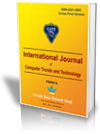Improvement in Qos using sink mobility in WSN
 |
International Journal of Computer Trends and Technology (IJCTT) |  |
| © - April Issue 2013 by IJCTT Journal | ||
| Volume-4 Issue-4 |
||
| Year of Publication : 2013 | ||
| Authors : Chandni,Kanika Sharma |

Chandni,Kanika Sharma "Improvement in Qos using sink mobility in WSN"International Journal of Computer Trends and Technology (IJCTT),V4(4):783-786 April Issue 2013 .ISSN 2231-2803.www.ijcttjournal.org. Published by Seventh Sense Research Group.
Abstract: -A wireless sensor network consists of large number of sensor nodes possessing the ability of sensing, computing and transmitting data from the harsh environment. The sensor node closer to the sink has to forward the data of the farther nodes along with its own. As a result of which the nodes lying near to the sink gets depleted in terms of energy than the other nodes which are lying farther from the sink. It results in network isolation or results in HOT SPOT problem. We have proposed an algorithm which will overcome the problem of average packet delivery rate in the network. This proposed algorithm has improved this factor to a significant extent. In this algorithm the position of the sink is optimized by applying ACO. The results of our extensive experiments on MATLAB demonstrated that our proposed routing algorithm was able to enhance the network’s throughput to a large extent.
References-
[1] K. Thanigaivelu, and K. Murugan, “Impact of Sink Mobility on Network Performance in Wireless Sensor Networks,” In: First IEEE International Conference on Networks & Communications, pp. 7-11, 2009.
[2] A. M. Zungeru, L. -M. Ang, S. R. S. Prabaharan, and K. P. Seng, “Ant Based Routing Protocol for Visual Sensors,” ICIEIS, part II, CCIS252, pp. 250-264, 2011.
[3] Y. Zhang, L.D. Kuhn, and M.P.J. Fromherz, “Improvements on Ant Routing for Sensor Networks,” Ant Colony Optimization and Swarm Intelligence, LNCS, 3172, pp. 289-313, 2004.
[4] C. Perkins, and E. Royer, “Ad-hoc on-demand distance vector routing,” in: Proceedings of Second IEEE Workshop on Mobile Computing Systems and Applications, 1999.
[5] M. Saleem, and M. Farooq, “Beesensor: A bee-inspired power aware routing algorithms,” Proc. EvoCOMNET, LNCS 3449, pp. 136-146, 2005.
[6] M. Roth, and S. Wicker, “Termite: ad-hoc networking with stigmergy,” GLOBECOM ’03, IEEE Global Telecommunications Conference, vol. 5, pp. 2937-2941, 2003.
[7] Termites 2011; [Accessed 18 October 2011], [online] Available at: < http://en.wikipedia.org/wiki/Termite>
[8] M. Marta, and M. Cardei, “Using Sink Mobility to Increase Wireless Sensor Networks Lifetime,” In: Proceedings of the Ninth IEEE Int’l Symp.World of Wireless, Mobile and Multimedia Networks, pp. 1- 10, 2008.
Keywords — -sink mobility; routing algorithm; wireless sensor network; swarm intelligence.
